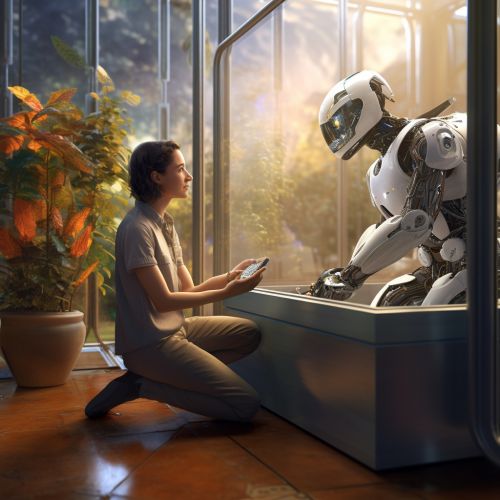Human-robot interaction
Introduction
Human-robot interaction (HRI) is a multidisciplinary field that explores the dynamics between humans and robots. It is a branch of AI that focuses on understanding, designing, and evaluating robotic systems for use by or with humans. The aim is to develop robots that can interact with humans in a natural and socially acceptable manner, whether they are autonomous systems or remotely controlled.


History and Development
The field of HRI emerged in the late 20th century, coinciding with the development of robots capable of more than just simple, pre-programmed tasks. Early research in the field was primarily focused on industrial applications, with robots designed to carry out repetitive tasks in controlled environments. However, as technology advanced, the focus shifted towards developing robots capable of interacting with humans in everyday environments.
Theoretical Framework
The theoretical framework of HRI is based on several disciplines, including robotics, psychology, anthropology, computer science, and cognitive science. These disciplines provide the necessary tools to study and understand the complex dynamics of human-robot interaction.
Types of Human-Robot Interaction
There are several types of human-robot interaction, which can be broadly classified into three categories: teleoperation, supervised autonomy, and full autonomy.
Teleoperation
In teleoperation, a human operator controls the robot remotely. This type of interaction is common in hazardous environments, such as nuclear power plants, or in surgical procedures, where a surgeon uses a robotic system to perform delicate operations.
Supervised Autonomy
In supervised autonomy, the robot performs tasks autonomously under the supervision of a human operator. The human operator can intervene and take control of the robot if necessary.
Full Autonomy
In full autonomy, the robot operates without any human intervention. It is capable of making decisions and performing tasks independently. This type of interaction is common in service robots, such as autonomous vacuum cleaners or lawn mowers.
Challenges in Human-Robot Interaction
Despite significant advancements in the field, there are still several challenges in human-robot interaction. These include issues related to safety, trust, privacy, and ethical considerations.
Safety
Ensuring safety in HRI is a major challenge. Robots must be designed to operate safely in the presence of humans, avoiding harm to people and property.
Trust
Building trust between humans and robots is another significant challenge. Humans must feel comfortable with robots, trusting them to perform tasks accurately and reliably.
Privacy
Privacy is a major concern in HRI, especially with robots that operate in domestic environments. These robots often have access to sensitive information, and ensuring this information is protected is a critical issue.
Ethical Considerations
There are also ethical considerations in HRI. These include questions about the responsibility for a robot's actions and the potential for robots to replace human jobs.
Future Directions
The field of human-robot interaction is rapidly evolving, with new technologies and applications emerging regularly. Future directions in the field include the development of social robots capable of understanding and responding to human emotions, and the integration of robots into everyday life in a way that is beneficial and acceptable to humans.
